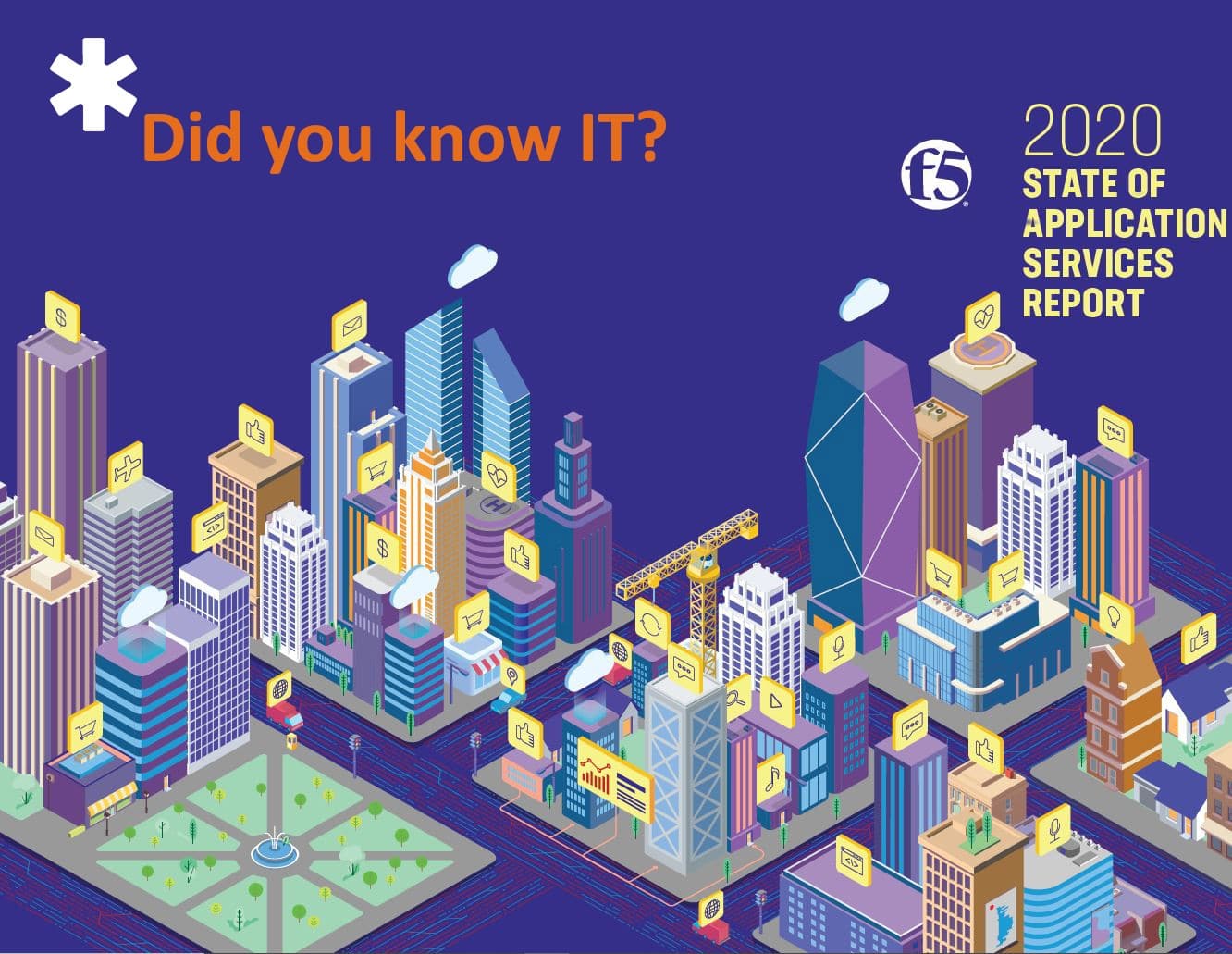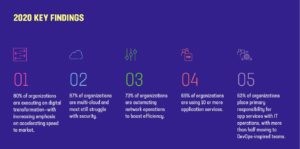
“Applications are the engines that power the digital economy”
Through what is broadly referred to as digital transformation, all businesses across all industries are becoming application centric with the goal of moving faster, boosting efficiency, and securely
delivering the digital customer—and employee—experiences the market demands. While the pace of change varies by organization, most digital transformation journeys follow a similar path:
Phase 1: Automating individual tasks to improve efficiencies by digitizing IT and business processes.
Phase 2: Integrating those discrete automated tasks and taking advantage of cloud-native infrastructures to scale the process with orchestration.
Phase 3: Harnessing and analyzing telemetry from application services to provide actionable business insights that prevent loss, predict capacity, optimize resources, and increase revenue.
2020 KEY FINDINGS
The Application Economy Evolves
“80% of organizations are executing on digital transformation—with increasing emphasis on accelerating speed to market”
As organizations progress through their digital transformation, IT and business process optimization initiatives mature. But what exactly are they doing? Many organizations are moving beyond the first phase of digital transformation—business process automation—and scaling their digital footprint with cloud, automation, and containers. This transformation results in the creation of new ecosystems and skyrocketing API call volumes. Organizations able to harness the application (and API) data and insights generated will be rewarded with significant business value.
INSIGHTS FOR KEY FINDING 01
It is time to manage the application portfolio like the business asset it is. First, focus on the application services required to secure, scale, and digitize IT and business processes. Automation and orchestration are key foundational tenets in this first phase of digital transformation. As organizations transition to the second phase, it is important to instrument application services to emit telemetry for unified visibility and control over policy enforcement. In the third phase, this telemetry from application services can be studied by cloud analytics tools to provide actionable operational and business insights such as predicting capacity, preventing loss, and delivering differentiated customer experiences.
Organizations Struggle With Security in the Cloud

“87% of organizations are multi-cloud and most still struggle with security”
Whether they are responding to government mandates or C-level demands, organizations use the public cloud to participate in industry ecosystems, leverage cloud-native architectures, and
deliver applications at the speed of the business. Despite the strategic imperative, organizations are much less confident in their ability to withstand an application-layer attack in the public cloud
versus in an on-premises data center. This discrepancy illustrates a real need for easy-to-deploy solutions that can ensure consistent security across multiple environments.
INSIGHTS FOR KEY FINDING 02
The notion of achieving a single application architecture or uniform infrastructure environment is a pipedream for most organizations of scale. Instead, leading organizations recognize that the most efficient and effective way to treat each application uniquely while operating and securing applications across heterogeneous architectures and environments is through a set of application services that abstract the application logic from the underlying infrastructure.
Automation and Orchestration Go Mainstream
“73% of organizations are automating network operations to boost efficiency”
Unsurprisingly, given that the primary drivers of digital transformation are IT and business process optimization, the majority of organizations are automating their network operations. Despite challenges, they’re gaining proficiency and moving toward continuous deployment with more consistent automation across all four key pipeline components: app infrastructure, app services, network, and security.
INSIGHTS FOR KEY FINDING 03
The increasing use of CI/CD tools in the deployment pipeline points to a preference for open ecosystems as a way to address the skill set gap plaguing enterprise IT. Organizations look for application services that are compatible with open ecosystems and bridge the skill sets of operations and DevOps.
Complex Environments Drive Adoption of New Application Services
“69% of organizations are using 10 or more application services”
Digital transformation, cloud platforms, and modern architectures are driving adoption of app services. As cloud- and container-native application architectures mature and scale, more organizations are deploying related app services, such as Ingress control and service discovery, both on premises and in the public cloud. Modern applications require modern app services to support scale, security, and availability requirements.
INSIGHTS FOR KEY FINDING 04
Achieving a successful application deployment necessitates taking full advantage of the wealth of application services available across categories (security, availability, performance, identity) and across generations of application architectures. Choosing the appropriate strategy means selecting application services that can be leveraged across these dimensions to reduce complexity and overcome skills deficits. This is especially true in security and performance use cases that tie directly to business outcomes of reducing risk and fraud, as well as enhancing customer experience.
IT Operations and DevOps Want Choice in Application Services
“63% of organizations still place primary responsibility for app services with IT operations, with more than half moving to DevOps-inspired teams”
As we’ve long suspected, operations and infrastructure teams continue to shoulder primary responsibility for selecting and deploying application services. However, as organizations expand their cloud- and container-native app portfolios, DevOps groups are taking more responsibility for app services.
INSIGHTS FOR KEY FINDING 05
As application portfolios transition to more modern architectures and IT organizations begin to align around more collaborative team structures, application services must evolve to provide ease of use for all skill sets within IT organizations. Maintaining a consistent set of app services while supporting choice in their infrastructure and platforms is key for both IT operations and DevOps teams as they work together to support the business.











